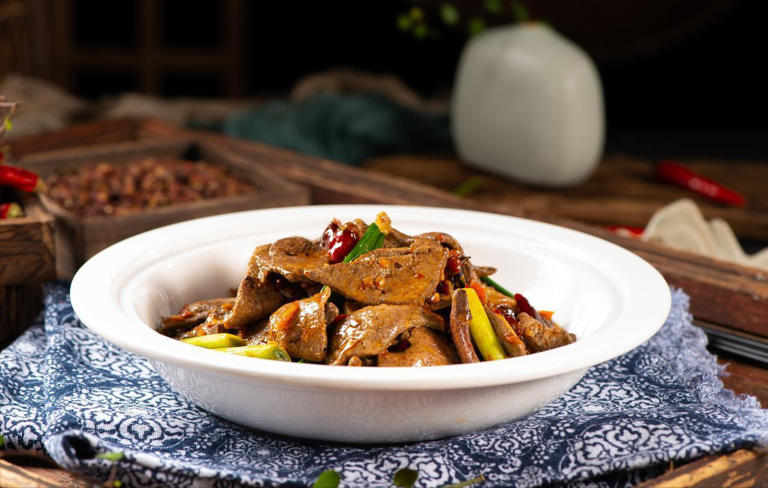Chinese people make a pot of fragrant sausages during the Chinese New Year, paired with garlic paste and vinegar sauce, which is a satisfying treat. But if you bring this dish to the table of a French or German person, they may stand up and ask you: What kind of junk food is this?
Europeans and Americans don’t really eat animal organs, not to mention pig intestines and lamb kidneys. Even chicken and duck blood, which we consider delicious, are basically given to cats over there. Why can’t the heart, liver, stomach, and intestines be on the table when they are all meat? Don’t they understand ‘using form to complement form’?
Today, let’s talk about why the common people in Europe and America are so distant from their internal organs?
This matter can be traced back hundreds of years. During the Middle Ages in Europe, ordinary people also consumed internal organs. At that time, we were poor. How could we waste a slaughtered cow? The liver, liver, spleen, lungs, and kidneys can be fully utilized. In the UK, there is a traditional dish called ‘Haggis’, which is actually made by wrapping lamb tripe with internal organs such as sheep liver and lungs. The Scots also consider it a national dish.

France also has high-end visceral dishes such as foie gras and calf thymus. So it’s not that Europeans and Americans are naturally averse to internal organs. But the key turning point occurred in the late 19th century to the mid-20th century, as the Industrial Revolution advanced, urbanization accelerated, and food production methods completely changed.
The rise of large-scale slaughterhouses emphasizes efficiency and standardization, and the processing of internal organs is complicated, with a short shelf life and easy contamination, gradually being marginalized. In addition, with the increasing awareness of public health at that time, areas such as pig liver and large intestine that were prone to harboring parasites or bacteria became key targets for prevention.
The US Department of Agriculture began to establish strict standards for meat processing as early as the early 20th century. Due to high risks and regulatory costs, internal organs gradually disappeared from the mainstream supply system.
Supermarkets exclusively sell pre cut pork loin, chicken breast, and steak, which are clean, uniform, and well packaged. Consumers have also become accustomed to this “visible safety”. Over time, the internal organs were labeled as “unhygienic” and “low-end”, and ordinary families naturally stopped touching them.
Another particularly important factor is the value ranking of food culture. In mainstream European and American concepts, food is not only something to fill the stomach, but also linked to identity and taste.

What you eat, to some extent, represents who you are. Like steak, lobster, and salmon, they are symbols of “dignity”, and when the restaurant menu is placed there, it appears to be upscale.
And what about the internal organs? In history, it was mostly the “scraps” that poor people ate, which were kept by butchers themselves or sold to the lowest level of laborers. For example, in the slums of 19th century London, there were indeed people who ate cow’s brain and pig intestines, but this precisely meant that they could not afford good meat.
With the development of social economy, the first thing people do after getting rid of poverty is to stay away from these ‘poor people’s food’. Psychologically, this is called ‘upward dietary migration’, where the richer one is, the more they want to eat things they couldn’t afford in the past, while abandoning cheap ingredients they relied on for survival.
So even if life improves later on, no one wants to go back and pick up their organs to eat.
On the contrary, traditional Chinese cuisine emphasizes the principle of “maximizing the use of resources”. The “Compendium of Materia Medica” also states that pork offal can treat frequent urination, and chicken offal can aid digestion. The common people believe in this and think that whatever they eat can be replenished, and the internal organs are actually precious.
Northeast China kills New Year pigs, and the whole family gathers in a circle to grab pigs and roast them; Guangdong soup must be made with pig bone marrow and chicken kidneys; Sichuan Chongqing hotpot with tripe, yellow throat, crispy and crisp texture, is the protagonist on the dining table. Cultural differences naturally lead to different value judgments.
In fact, the nutritional value of internal organs is very high. Pig liver is rich in vitamin A and iron, which is much stronger than spinach; The heart contains coenzyme Q10 and high-quality protein; The kidneys are rich in potassium and B vitamins. In theory, it should be vigorously promoted.
The problem is that the Western nutrition community has always been cautious about the attitude towards internal organs.
Although the American dietary guidelines do not prohibit the consumption of liver, they explicitly remind pregnant women not to overeat, as excessive vitamin A may affect fetal development. In addition, modern people generally have an excess of calories and high levels of cholesterol in the liver. Doctors often advise cardiovascular disease patients to control their intake.
In this way, the official voice itself carries a reserved attitude, and the public is even more afraid to try it easily.

Chinese people make a pot of fragrant sausages during the Chinese New Year, paired with garlic paste and vinegar sauce, which is a satisfying treat. But if you bring this dish to the table of a French or German person, they may stand up and ask you: What kind of junk food is this? Europeans and Americans really don’t eat animal organs. Not to mention pig intestines and lamb kidneys, even chicken and duck blood, which are delicious in our eyes, are basically not eaten there
In contrast, the Chinese Dietary Guidelines for Residents mention moderate consumption of animal liver, especially recommended for people with iron deficiency anemia, but also emphasize “once or twice a month, about 25 grams each time”. It can be seen that neither side is completely negative, only the application method is different.
But in the eyes of ordinary European and American people, whenever they hear words like “high cholesterol” or “vitamin A is toxic”, they immediately give up and would rather choose to boil chicken breast in water.

Why don’t European and American foreigners eat animal organs, including hearts, fat intestines, etc.? Why is that?
Once a certain ingredient exits the mainstream consumption chain, it is difficult to come back. Nowadays, fresh pork brain and lamb belly are almost impossible to see in supermarkets in Europe and America. It’s not that no one wants to sell them, but the supply chain is broken.
Cattle farms, slaughterhouses, and cold chain transportation are all designed around standardized meat chunks, and processing internal organs separately requires additional equipment and manpower, resulting in high costs.
Why don’t European and American foreigners eat animal organs, including hearts, fat intestines, etc.? Why is that?
I also don’t want to take the risk of having a dish that nobody ordered on the restaurant menu. Consumers who have never seen or eaten it will naturally not want to eat, forming a vicious cycle. On the other hand, in China, agricultural markets supply various fresh viscera all year round, and vendors also teach you how to remove fishy odors and blanch water. Every household has their own ancestral methods.
This kind of dynamic inheritance keeps internal organs in daily diet. In recent years, some high-end Western restaurants have started to play with the concept of “nose to tail” (eating from head to tail), advocating the use of all animals and reducing waste. For example, a Michelin restaurant in London uses beef bone marrow for sauce, and a chef in New York uses pork ear for salad.
But this is more of a niche trend within the elite circle, far from the mainstream dining table. Foreigners don’t eat internal organs, not because they are “stupid” or “don’t know how to eat”. Behind every dietary habit, there is a heavy social development history.
















暂无评论内容